Almonds
The almond we are familiar with is actually the seed, or pit, of the almond fruit which is borne by a beautiful tree that flowers in fragrant pink and white flowers. In the same family as the peach, cherry and apricot, the almond fruit, called a drupe, has a stone-like seed within. Two varieties of the almond have been treasured for millennia: sweet (Prunus amygdalus dulcis) and bitter (Prunus amygdalus amara).
Sweet Almonds
Sweet almonds are the type we love to eat. They are oval in shape, with a crunchy texture and mild, but distinct, taste. They are commonly sold in the U.S. with the shell removed, though in some cultures, the nut is still in the shell. Shelled almonds are available whole – with a thin brown skin, or blanched, with the skin removed. Blanched almonds are also sold in packages already sliced or slivered.
Bitter Almonds
Bitter almonds are inedible and contain hydrocyanic acid, a toxic substance. They are processed to remove the acid, then pressed to produce a rich, fragrant almond oil commonly used as a flavoring agent for foods and liqueurs such as Amaretto and Disaronno.
History of Almonds
Almonds are an ancient source of food documented in early Middle Eastern historical texts, and the Bible. The first known use of almonds, according to archaeologists, occurred nearly 5,000 years ago during the Bronze Age, in western Asia, the Mediterranean, and North Africa. Early Romans named the almond the "Greek nut," indicating that they may have been first cultivated in Greece.
The highest production of almonds historically came from countries bordering the Mediterranean Sea, particularly Spain, Italy, Portugal and Morocco, but the trees were introduced in California during the middle of the 19th century. The gentle climate in the Central Valley proved to be perfect for the almond, and now 80 percent of the world supply of almonds come from California and they are the third largest export crop.
Nutritional Facts
Almonds are high in monounsaturated fats which are known to contribute to reduced risk of heart disease. Olive oil has the same type of fats, and researchers have discovered that substituting almonds for an equivalent amount of carbohydrates from other sources resulted in a 30 percent reduction in heart disease risk. Even greater risk reduction – 45 percent – was recorded when nuts replaced saturated fats, such as meat and dairy products, in the diet.
A fourth of a cup of almonds contains 205 calories and these vitamins and minerals:
Manganese, Vitamin E, Magnesium, Tryptophan, Copper, Vitamin B2, Phosphorus, Selenium, Potassium, Iron


